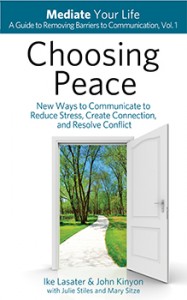Choosing Peace

Nonbelievers frequently debate the best way to communicate our ideas. Some think that a brash style is the most effective way to get attention. Others believe that a softer approach is the best way to change hearts and minds.
For those seeking to apply the softer approach, a useful technique is called “nonviolent communication.” Pioneered by the psychologist Marshall Rosenberg, NVC avoids rhetorical violence and seeks to de-escalate conflict. Ike Lasater and John Kinyon, associates of Rosenberg, have written Choosing Peace: New Ways to Communicate to Reduce Stress, Create Connection, and Resolve Conflict as a manual to help readers put these techniques into practice.
When communicating in the NVC style, the first step is to describe a situation objectively without any judgments or “spin.” The second is to say how this makes you feel. The third element is to dig a little deeper and explain what values or needs make you feel this way. This third step can be particularly challenging. The final and optional step is to make a request of the person with whom you’re communicating.
One advantage of this approach is that it eases people into an agreeable frame of mind. If you thunder, “This is outrageous!” your opponent will try to rebut you. If you say, “I’m outraged by this,” your opponent will concede the truth of this statement.
To demonstrate the practice, Lasater and Kinyon present a fictional scenario in which siblings are in conflict over taking care of an aging mother. Rather than recap this story, it might be more illustrative to imagine how to apply the NVC method to the American Humanist Association’s current campaign regarding the Pledge of Allegiance.
The AHA is encouraging people to sit during the recitation of the pledge until the phrase “under God” is removed. When a student sits during the pledge, it’s likely that fellow classmates will ask why. The student might answer, “It’s stupid to recite the pledge because it contains the words ‘under God’ and it’s obvious to anyone with brains that God does not exist.”
Upon hearing the word “stupid,” classmates will likely infer that they’re being called stupid. If so, they may naturally react with anger and may even escalate things with their own epithets. Using the NVC approach, the seated student might say, “When the class says the words ‘under God,’ I feel uncomfortable because I can’t say them in all honesty. I hope you’ll respect that and I wonder whether you might sit along with me next time so I don’t feel like an outcast.”
Acknowledging that one has emotions does not lead to emotional decision-making. Quite the opposite. It’s when we are unconscious of our emotions that we make emotional decisions without any awareness of doing so. When we acknowledge that we are mammals with brains that generate emotions, we can then gain some perspective about our feelings and biases and make more rational decisions.
NVC is an appealing approach, but the question is, does it work? Authors Lasater and Kinyon argue that it is robust and works cross-culturally, noting that shortly after the 9/11 terrorist attacks, their training was well received by Afghan elders in Peshawar, Pakistan, a city close to the border with Afghanistan.
The book takes as a starting point that, for better or worse, you’re actually in a dialogue with your opponents. But what if you are being ignored? It may be that activists need to be rowdy and provocative to place their issue on the public’s agenda. Having gained public attention, however, further use of polarizing rhetoric by activists can produce a backlash; shifting to nonviolent communication may be a better way to achieve a breakthrough.
Choosing Peace builds on Marshall Rosenberg’s 2003 book, Nonviolent Communication: A Language of Life. Rosenberg himself was a student of humanistic psychologist Carl Rogers. Lasater, trained as a lawyer, acknowledges Zen influences in his own philosophy. The NVC approach is compatible with the Buddhist concept of skillful speech in general, but adds specific implementation details. Kinyon, trained as a clinical psychologist, suggests in a personal epilogue that these techniques have a deeper, spiritual “energy” behind them. However, none of the techniques presented use any form of spiritual language. Secular humanists can apply them without modification.
Choosing Peace is conceived of as the introductory volume of a multi-book series. For those with little knowledge of nonviolent communication the new book is a fine introduction to the technique and could prove helpful in resolving conflicts within the family and in society at large. Those already familiar with Rosenberg’s technique may not gain much from reading the new volume.
Among the authors’ motivations for the series, they’ve found that “the basic NVC model was not sufficient in stressful situations, when the fight-or-flight reaction was triggered.” They go into a bit of this in the introductory volume—for instance, suggesting that couples who have agreed to use NVC adopt an “awareness password” to remind their partner to return to the practice when they appear to have departed from it. However, a more detailed exposition of their enhanced NVC process appears to be reserved for future volumes in the series. If they deliver on these promises, the series will be a valuable addition to the literature on compassionate communication.
